Resiliency and Risk Assessment of Smart Vision-Based Skin Screening Applications with Dynamics Modeling
Abstract
:1. Introduction
1.1. Background and Significance
1.2. Key Contributions and Novelty
2. Risk Management and Resiliency
- Risk identification: This stage involves discovering all relevant risks that can influence the operations within an enterprise (or system) [66]. These risks might stem from internal and external sources relative to the boundaries of the enterprise [67]. Internal sources generally include production delays, equipment breakdown, or accidents, while external sources mainly include pandemics, cyber-attacks, natural disasters, production or quality problems at the suppliers’ plants, or transportation accidents [68].
- Risk assessment: Supply chain risks are commonly characterized by the probability of their occurrence and the severity of their impact. This stage of the process involves assessing these factors for the identified risks from the risk identification stage [66]. Additionally, in this stage, the risks are ranked based on the enterprise’s risk threshold or tolerance [68].
- Risk management: In this stage, strategies for the probability or severity of the identified supply chain risks are determined. This encompasses options such as risk acceptance (i.e., taking no action to mitigate the risk) and devising approaches for risk avoidance, transfer, or mitigation [69].
3. Materials and Methods
3.1. Causal Model
3.2. System Dynamics Model
 =
=AScaling Factor ×[(data management capability level) ×
(1 − diagnosis variability level) ×
(simplicity of app interface level)×
(skin lesion screening viability process level) ×
(level of user contentment) × (1 − delay)]
+δOffset
4. Results
4.1. Baseline Case
4.2. Case #1
4.3. Case #2
4.4. Case #3
4.5. Case #4
4.6. Case #5
4.7. Case #6
5. Discussion
6. Conclusions
Author Contributions
Funding
Institutional Review Board Statement
Informed Consent Statement
Data Availability Statement
Conflicts of Interest
References
- Skin Cancer Foundation. Skin Cancer Facts & Statistics. Available online: https://www.skincancer.org/skin-cancer-information/skin-cancer-facts (accessed on 31 July 2023).
- The American Melanoma Foundation Skin Cancer Facts Sheet. Available online: https://melanomafoundation.org/statistics (accessed on 31 July 2023).
- National Cancer Institute. Cancer Trends Progress Report. Available online: http://progressreport.cancer.gov/ (accessed on 31 July 2023).
- American Cancer Society. 2023 Cancer Facts and Figures. Available online: https://www.cancer.org/research/cancer-facts-statistics/all-cancer-facts-figures/2023-cancer-facts-figures.html (accessed on 31 July 2023).
- Siegel, R.; Naishadham, D.; Jemal, A. Cancer statistics, 2013. CA A Cancer J. Clin. 2013, 63, 11–30. [Google Scholar] [CrossRef]
- Rueth, N.M.; Cromwell, K.D.; Cormier, J.N. Long-term follow-up for melanoma patients: Is there any evidence of a benefit? Surg. Oncol. Clin. 2015, 24, 359–377. [Google Scholar] [CrossRef] [PubMed]
- U.S. News, Health, Melanoma Stages: Prognosis, Survival Rates and Treatment. Available online: https://health.usnews.com/conditions/cancer/skin-cancer/articles/melanoma-stages-prognosis-survival-rates-and-treatment (accessed on 31 July 2023).
- American Academy of Dermatology Association, Artificial Intelligence Shows Promise for Skin Cancer Detection. Available online: https://www.aad.org/news/ai-and-skin-cancer-detection (accessed on 31 July 2023).
- Suha, S.A.; Sanam, T.F. A deep convolutional neural network-based approach for detecting burn severity from skin burn images. Mach. Learn. Appl. 2022, 9, 100371. [Google Scholar] [CrossRef]
- Yadav, D.; Sharma, A.; Singh, M.; Goyal, A. Feature extraction based machine learning for human burn diagnosis from burn images. IEEE J. Transl. Eng. Health Med. 2019, 7, 1800507. [Google Scholar] [CrossRef] [PubMed]
- Gouda, W.; Sama, N.U.; Al-Waakid, G.; Humayun, M.; Jhanjhi, N.Z. Detection of skin cancer based on skin lesion images using deep learning. Healthcare 2022, 10, 1183. [Google Scholar] [CrossRef] [PubMed]
- Kopf, A.W.; Mintzis, M.; Bart, R.S. Diagnostic accuracy in malignant melanoma. Arch. Dermatol. 1975, 111, 1291–1292. [Google Scholar] [CrossRef]
- Lightstone, A.C.; Kopf, A.W.; Garfinkel, L. Diagnostic Accuracy—A New Approach to Its Evaluation: Results in Basal Cell Epitheliomas. Arch. Dermatol. 1965, 91, 497–502. [Google Scholar] [CrossRef]
- Rampen, F.; Rümke, P. Referral pattern and accuracy of clinical diagnosis of cutaneous melanoma. Acta Derm.-Venereol. 1988, 68, 61–64. [Google Scholar]
- Rosendahl, C.; Tschandl, P.; Cameron, A.; Kittler, H. Diagnostic accuracy of dermatoscopy for melanocytic and nonmelanocytic pigmented lesions. J. Am. Acad. Dermatol. 2011, 64, 1068–1073. [Google Scholar] [CrossRef]
- Matteucci, P.; Pinder, R.; Magdum, A.; Stanley, P. Accuracy in skin lesion diagnosis and the exclusion of malignancy. J. Plast. Reconstr. Aesthetic Surg. 2011, 64, 1460–1465. [Google Scholar] [CrossRef]
- Clebak, K.T.; Helm, L.; Helm, M. Accuracy of dermoscopy vs. visual inspection for diagnosing melanoma in adults. Am. Fam. Physician 2020, 101, 145–146. [Google Scholar]
- Lindelöf, B.; Hedblad, M.A. Accuracy in the clinical diagnosis and pattern of malignant melanoma at a dermatological clinic. J. Dermatol. 1994, 21, 461–464. [Google Scholar] [CrossRef] [PubMed]
- Weinstock, M.; Lott, J.; Wang, Q.; Titus, L.; Onega, T.; Nelson, H.; Pearson, L.; Piepkorn, M.; Barnhill, R.; Elmore, J.; et al. Skin biopsy utilization and melanoma incidence among Medicare beneficiaries. Br. J. Dermatol. 2017, 176, 949–954. [Google Scholar] [CrossRef] [PubMed]
- Argenziano, G.; Mordente, I.; Ferrara, G.; Sgambato, A.; Annese, P.; Zalaudek, I. Dermoscopic monitoring of melanocytic skin lesions: Clinical outcome and patient compliance vary according to follow-up protocols. Br. J. Dermatol. 2008, 159, 331–336. [Google Scholar] [CrossRef] [PubMed]
- Argenziano, G.; Zalaudek, I.; Giacomel, J. Dermoscopy, an Issue of Dermatologic Clinics; Elsevier Health Sciences: Amsterdam, The Netherlands, 2013; Volume 31. [Google Scholar]
- Abuzaghleh, O.; Barkana, B.D.; Faezipour, M. Noninvasive real-time automated skin lesion analysis system for melanoma early detection and prevention. IEEE J. Transl. Eng. Health Med. 2015, 3, 4300212. [Google Scholar] [CrossRef]
- Shoieb, D.A.; Youssef, S.M.; Aly, W.M. Computer-aided model for skin diagnosis using deep learning. J. Image Graph. 2016, 4, 122–129. [Google Scholar] [CrossRef]
- Vinay, K.; Vishal, K. Smartphone applications for medical students and professionals. Nitte Univ. J. Health Sci. 2013, 3, 59. [Google Scholar]
- Kratzke, C.; Cox, C. Smartphone technology and apps: Rapidly changing health promotion. Glob. J. Health Educ. Promot. 2012, 15, 72–82. [Google Scholar]
- Mary, G.A.A.; Sathyasri, B.; Murali, K.; Prabhu, L.A.J.; Bharatha Devi, N. Electrocardiogram signal classification in an IoT environment using an adaptive deep neural networks. Neural Comput. Appl. 2023, 35, 15333–15342. [Google Scholar] [CrossRef]
- Khanna, A.; Selvaraj, P.; Gupta, D.; Sheikh, T.H.; Pareek, P.K.; Shankar, V. Internet of things and deep learning enabled healthcare disease diagnosis using biomedical electrocardiogram signals. Expert Syst. 2023, 40, e12864. [Google Scholar] [CrossRef]
- Altaheri, H.; Muhammad, G.; Alsulaiman, M.; Amin, S.U.; Altuwaijri, G.A.; Abdul, W.; Bencherif, M.A.; Faisal, M. Deep learning techniques for classification of electroencephalogram (EEG) motor imagery (MI) signals: A review. Neural Comput. Appl. 2023, 35, 14681–14722. [Google Scholar] [CrossRef]
- Brown, C.; Chauhan, J.; Grammenos, A.; Han, J.; Hasthanasombat, A.; Spathis, D.; Xia, T.; Cicuta, P.; Mascolo, C. Exploring automatic diagnosis of covid-19 from crowdsourced respiratory sound data. arXiv 2020, arXiv:2006.05919. [Google Scholar]
- Faezipour, M.; Abuzneid, A. Smartphone-Based Self-Testing of COVID-19 Using Breathing Sounds. Telemed. e-Health 2020, 26, 1202–1205. [Google Scholar] [CrossRef] [PubMed]
- Han, J.; Brown, C.; Chauhan, J.; Grammenos, A.; Hasthanasombat, A.; Spathis, D.; Xia, T.; Cicuta, P.; Mascolo, C. Exploring Automatic COVID-19 Diagnosis via voice and symptoms from Crowdsourced Data. In Proceedings of the ICASSP 2021–2021 IEEE International Conference on Acoustics, Speech and Signal Processing (ICASSP), Toronto, ON, Canada, 6–11 June 2021; pp. 8328–8332. [Google Scholar]
- Cinyol, F.; Baysal, U.; Köksal, D.; Babaoğlu, E.; Ulaşlı, S.S. Incorporating support vector machine to the classification of respiratory sounds by Convolutional Neural Network. Biomed. Signal Process. Control 2023, 79, 104093. [Google Scholar] [CrossRef]
- Bordoloi, D.; Singh, V.; Kaliyaperumal, K.; Ritonga, M.; Jawarneh, M.; Kassanuk, T.; Quiñonez-Choquecota, J. Classification and detection of skin disease based on machine learning and image processing evolutionary models. Comput. Assist. Methods Eng. Sci. 2023, 30, 247–256. [Google Scholar]
- Inthiyaz, S.; Altahan, B.R.; Ahammad, S.H.; Rajesh, V.; Kalangi, R.R.; Smirani, L.K.; Hossain, M.A.; Rashed, A.N.Z. Skin disease detection using deep learning. Adv. Eng. Softw. 2023, 175, 103361. [Google Scholar] [CrossRef]
- Kumar, Y.; Gupta, S. Deep transfer learning approaches to predict glaucoma, cataract, choroidal neovascularization, diabetic macular edema, drusen and healthy eyes: An experimental review. Arch. Comput. Methods Eng. 2023, 30, 521–541. [Google Scholar] [CrossRef]
- Bhat, W.A.; Ahmed, S.; Khan, A.A.; Ahmad, A.; Dar, A.A.; Reegu, F.A.; Arumugam, M. Cataract eye detection by optik image analysis using encoder basis Boltzmann architecture integrated with internet of things and data mining. Opt. Quantum Electron. 2023, 55, 917. [Google Scholar] [CrossRef]
- Alsos, O.A.; Das, A.; Svanæs, D. Mobile health IT: The effect of user interface and form factor on doctor–patient communication. Int. J. Med. Inform. 2012, 81, 12–28. [Google Scholar] [CrossRef]
- Kassem, M.A.; Hosny, K.M.; Damaševičius, R.; Eltoukhy, M.M. Machine learning and deep learning methods for skin lesion classification and diagnosis: A systematic review. Diagnostics 2021, 11, 1390. [Google Scholar] [CrossRef] [PubMed]
- Olayah, F.; Senan, E.M.; Ahmed, I.A.; Awaji, B. AI techniques of dermoscopy image analysis for the early detection of skin lesions based on combined CNN features. Diagnostics 2023, 13, 1314. [Google Scholar] [CrossRef] [PubMed]
- Esteva, A.; Kuprel, B.; Novoa, R.A.; Ko, J.; Swetter, S.M.; Blau, H.M.; Thrun, S. Dermatologist-level classification of skin cancer with deep neural networks. Nature 2017, 542, 115–118. [Google Scholar] [CrossRef] [PubMed]
- Gulati, S.; Bhogal, R.K. Classification of melanoma from dermoscopic images using machine learning. In Proceedings of the Smart Intelligent Computing and Applications: Proceedings of the Third International Conference on Smart Computing and Informatics; Springer: Singapore, 2020; Volume 1, pp. 345–354. [Google Scholar]
- Freeman, K.; Dinnes, J.; Chuchu, N.; Takwoingi, Y.; Bayliss, S.E.; Matin, R.N.; Jain, A.; Walter, F.M.; Williams, H.C.; Deeks, J.J. Algorithm based smartphone apps to assess risk of skin cancer in adults: Systematic review of diagnostic accuracy studies. BMJ 2020, 368, m127. [Google Scholar] [CrossRef]
- Chaturvedi, S.S.; Gupta, K.; Prasad, P.S. Skin lesion analyser: An efficient seven-way multi-class skin cancer classification using MobileNet. In Proceedings of the Advanced Machine Learning Technologies and Applications: Proceedings of AMLTA 2020; Springer: Singapore, 2021; pp. 165–176. [Google Scholar]
- Srinivasu, P.N.; SivaSai, J.G.; Ijaz, M.F.; Bhoi, A.K.; Kim, W.; Kang, J.J. Classification of skin disease using deep learning neural networks with MobileNet V2 and LSTM. Sensors 2021, 21, 2852. [Google Scholar] [CrossRef] [PubMed]
- Kousis, I.; Perikos, I.; Hatzilygeroudis, I.; Virvou, M. Deep learning methods for accurate skin cancer recognition and mobile application. Electronics 2022, 11, 1294. [Google Scholar] [CrossRef]
- Abuzaghleh, O.; Faezipour, M.; Barkana, B.D. Skincure: An innovative smart phone-based application to assist in melanoma early detection and prevention. Signal Image Process. Int. J. (SIPIJ) 2014, 5. [Google Scholar] [CrossRef]
- DermLite Handyscope. Available online: https://dermatoscopes.com/products/dermlite-handyscope (accessed on 5 September 2023).
- Birta, L.G.; Arbez, G. Modelling and Simulation; Springer: Berlin/Heidelberg, Germany, 2013. [Google Scholar]
- Sterman, J. System Dynamics: Systems Thinking and Modeling for a Complex World; Working Paper Series: ESD Internal Symposium; Massachusetts Institute of Technology Engineering Systems Division: Cambridge, MA, USA, 2002. [Google Scholar]
- Merrill, J.A.; Deegan, M.; Wilson, R.V.; Kaushal, R.; Fredericks, K. A system dynamics evaluation model: Implementation of health information exchange for public health reporting. J. Am. Med. Inform. Assoc. 2013, 20, e131–e138. [Google Scholar] [CrossRef]
- Forrester, J.W. System dynamics, systems thinking, and soft OR. Syst. Dyn. Rev. 1994, 10, 245–256. [Google Scholar] [CrossRef]
- Darabi, N.; Hosseinichimeh, N. System Dynamics Modeling in Health and Medicine: A Systematic Literature Review. Syst. Dyn. Rev. 2020, 36, 29–73. [Google Scholar] [CrossRef]
- Hirsch, G.B.; Homer, J. System dynamics applications to health care in the United States. In System Dynamics: Theory and Applications; Springer: Berlin/Heidelberg, Germany, 2020; pp. 209–227. [Google Scholar]
- Wolstenholme, E.; McKelvie, D. The Dynamics of Care: Understanding People Flows in Health and Social Care; Springer International Publishing: Cham, Switzerland, 2019. [Google Scholar] [CrossRef]
- Faezipour, M.; Ferreira, S. A System Dynamics Perspective of Patient Satisfaction in Healthcare. Procedia Comput. Sci. 2013, 16, 148–156. [Google Scholar] [CrossRef]
- Faezipour, M.; Ferreira, S. A system dynamics approach for sustainable water management in hospitals. IEEE Syst. J. 2018, 12, 1278–1285. [Google Scholar] [CrossRef]
- Leung, L.W.; Roudsari, A.V.; Kuo, A.; Courtney, K.L. System Dynamics in Remote Monitoring Service for Cardiovascular Implantable Electronic Devices. In Improving Usability, Safety and Patient Outcomes with Health Information Technology; IOS Press: Amsterdam, The Nertherlands, 2019; pp. 277–282. [Google Scholar]
- de Andrade, L.; Lynch, C.; Carvalho, E.; Rodrigues, C.G.; Vissoci, J.R.N.; Passos, G.F.; Pietrobon, R.; Nihei, O.K.; de Barros Carvalho, M.D. System dynamics modeling in the evaluation of delays of care in ST-segment elevation myocardial infarction patients within a tiered health system. PLoS ONE 2014, 9, e103577. [Google Scholar] [CrossRef]
- Kunc, M.; Kazakov, R. Competitive dynamics in pharmaceutical markets: A case study in the chronic cardiac disease market. J. Oper. Res. Soc. 2013, 64, 1790–1799. [Google Scholar] [CrossRef]
- Faezipour, M.; Faezipour, M. System dynamics modeling for smartphone-based healthcare tools: Case study on ECG monitoring. IEEE Syst. J. 2021, 15, 3036–3045. [Google Scholar] [CrossRef]
- Faezipour, M.; Faezipour, M. Sustainable smartphone-based healthcare systems: A systems engineering approach to assess the efficacy of respiratory monitoring apps. Sustainability 2020, 12, 5061. [Google Scholar] [CrossRef]
- Faezipour, M.; Faezipour, M. Efficacy of Smart EEG Monitoring Amidst the COVID-19 Pandemic. Electronics 2021, 10, 1001. [Google Scholar] [CrossRef]
- Pourreza, S.; Faezipour, M.; Faezipour, M. Eye-SCOR: A Supply Chain Operations Reference-Based Framework for Smart Eye Status Monitoring Using System Dynamics Modeling. Sustainability 2022, 14, 8876. [Google Scholar] [CrossRef]
- APICS Supply Chain Operations Reference Model SCOR Version 12.0. Available online: http://apics.org/scor (accessed on 30 July 2023).
- Ho, W.; Zheng, T.; Yildiz, H.; Talluri, S. Supply chain risk management: A literature review. Int. J. Prod. Res. 2015, 53, 5031–5069. [Google Scholar] [CrossRef]
- Zsidisin, G.A.; Henke, M. Revisiting Supply Chain Risk; Springer: Berlin/Heidelberg, Germany, 2019. [Google Scholar]
- Christopher, M.; Lowson, R.; Peck, H. Creating agile supply chains in the fashion industry. Int. J. Retail. Distrib. Manag. 2004, 32, 367–376. [Google Scholar] [CrossRef]
- Polyviou, M.; Ramos, G.; Schneller, E. Supply Chain Risk Management: An Enterprise View and a Survey of Methods. In Supply Chain Risk Mitigation: Strategies, Methods and Applications; Springer: Berlin/Heidelberg, Germany, 2022; pp. 27–58. [Google Scholar]
- Chapman, C. Key points of contention in framing assumptions for risk and uncertainty management. Int. J. Proj. Manag. 2006, 24, 303–313. [Google Scholar] [CrossRef]
- Ponomarov, S.Y.; Holcomb, M.C. Understanding the concept of supply chain resilience. Int. J. Logist. Manag. 2009, 20, 124–143. [Google Scholar] [CrossRef]
- Fiksel, J. A framework for sustainable materials management. JOM 2006, 58, 15–22. [Google Scholar] [CrossRef]
- Hosseini, S.; Barker, K.; Ramirez-Marquez, J.E. A review of definitions and measures of system resilience. Reliab. Eng. Syst. Saf. 2016, 145, 47–61. [Google Scholar] [CrossRef]
- Youn, B.D.; Hu, C.; Wang, P. Resilience-driven system design of complex engineered systems. J. Mech. Des. 2011, 133, 101011. [Google Scholar] [CrossRef]
- Hollnagel, E.; Woods, D.D.; Leveson, N. Resilience Engineering: Concepts and Precepts; Ashgate Publishing, Ltd.: Farnham, UK, 2006. [Google Scholar]
- Hollnagel, E. Prolog-The Scope of resilience Engineering. Resil. Eng. Pract. 2011. [Google Scholar]
- Wang, Y. Resilience quantification for probabilistic design of cyber-physical system networks. ASCE-ASME J. Risk Uncertain. Eng. Syst. Part B Mech. Eng. 2018, 4, 031006. [Google Scholar] [CrossRef]
- Lindbom, H.; Tehler, H.; Eriksson, K.; Aven, T. The capability concept–On how to define and describe capability in relation to risk, vulnerability and resilience. Reliab. Eng. Syst. Saf. 2015, 135, 45–54. [Google Scholar] [CrossRef]
- Gallopín, G.C. Linkages between vulnerability, resilience, and adaptive capacity. Glob. Environ. Change 2006, 16, 293–303. [Google Scholar] [CrossRef]
- Gomes, L.d.C. Mitigation of Supply Chain Vulnerability Through Collaborative Planning, Forecasting, and Replenishment (CPFR). In Supply Chain Risk Mitigation: Strategies, Methods and Applications; Springer: Berlin/Heidelberg, Germany, 2022; pp. 95–119. [Google Scholar]
- Pettit, T.J.; Fiksel, J.; Croxton, K.L. Ensuring supply chain resilience: Development of a conceptual framework. J. Bus. Logist. 2010, 31, 1–21. [Google Scholar] [CrossRef]
- Pettit, T.J.; Croxton, K.L.; Fiksel, J. Ensuring supply chain resilience: Development and implementation of an assessment tool. J. Bus. Logist. 2013, 34, 46–76. [Google Scholar] [CrossRef]
- Dinh, L.T.; Pasman, H.; Gao, X.; Mannan, M.S. Resilience engineering of industrial processes: Principles and contributing factors. J. Loss Prev. Process Ind. 2012, 25, 233–241. [Google Scholar] [CrossRef]
- Fried, L.; Tan, A.; Bajaj, S.; Liebman, T.N.; Polsky, D.; Stein, J.A. Technological advances for the detection of melanoma: Advances in diagnostic techniques. J. Am. Acad. Dermatol. 2020, 83, 983–992. [Google Scholar] [CrossRef]
- Kränke, T.; Tripolt-Droschl, K.; Röd, L.; Hofmann-Wellenhof, R.; Koppitz, M.; Tripolt, M. New AI-algorithms on smartphones to detect skin cancer in a clinical setting—A validation study. PLoS ONE 2023, 18, e0280670. [Google Scholar] [CrossRef]
- Welsh, T.; Benkhelifa, E. On resilience in cloud computing: A survey of techniques across the cloud domain. Acm Comput. Surv. 2020, 53, 1–36. [Google Scholar] [CrossRef]
- Vensim Software. Available online: https://vensim.com/vensim-software/#professional-amp-dss (accessed on 31 July 2023).
- Cardiac Rehabilitation. Available online: https://www.mayoclinic.org/tests-procedures/cardiac-rehabilitation/about/pac-20385192. (accessed on 30 July 2023).
- Why Follow-Up Care Is Key to Recovery After Your Heart Attack. Available online: https://health.clevelandclinic.org/why-follow-up-care-is-key-to-recovery-after-your-heart-attack/ (accessed on 30 July 2023).
- Kim, S.C.; Yoon, D.; Han, E.K. Antecedents of mobile app usage among smartphone users. J. Mark. Commun. 2016, 22, 653–670. [Google Scholar] [CrossRef]
- Andrawis, J.P.; Muzykewicz, D.A.; Franko, O.I. Mobile device trends in orthopedic surgery: Rapid change and future implications. Orthopedics 2016, 39, e51–e56. [Google Scholar] [CrossRef] [PubMed]
- Forrester, J.W.; Senge, P.M. Tests for building confidence in system dynamics models. Syst. Dyn. Tims Stud. Manag. Sci. 1980, 14, 209–228. [Google Scholar]
- Richardson, G.P.; Pugh, A.I., III. Introduction to System Dynamics Modeling with DYNAMO; Productivity Press Inc.: New York, NY, USA, 1981. [Google Scholar]
- Barlas, Y. Formal aspects of model validity and validation in system dynamics. Syst. Dyn. Rev. J. Syst. Dyn. Soc. 1996, 12, 183–210. [Google Scholar] [CrossRef]

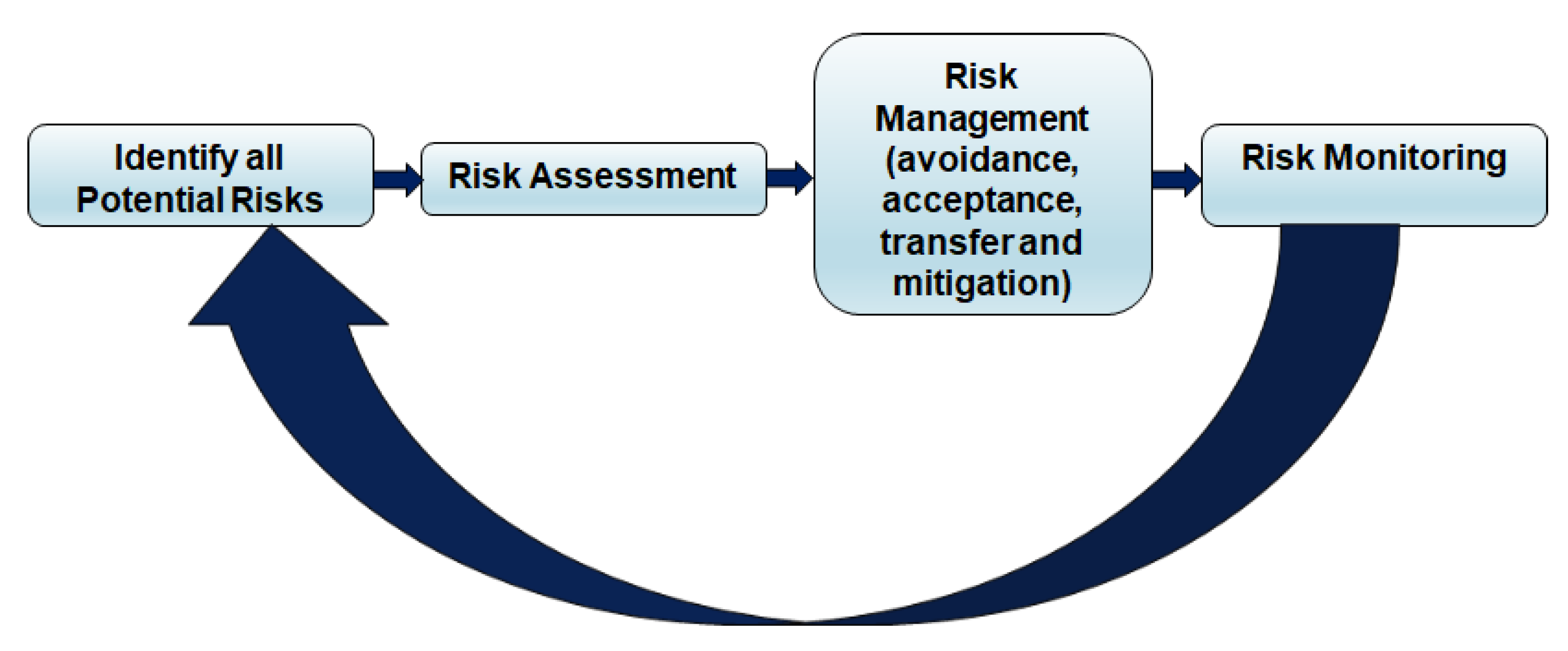

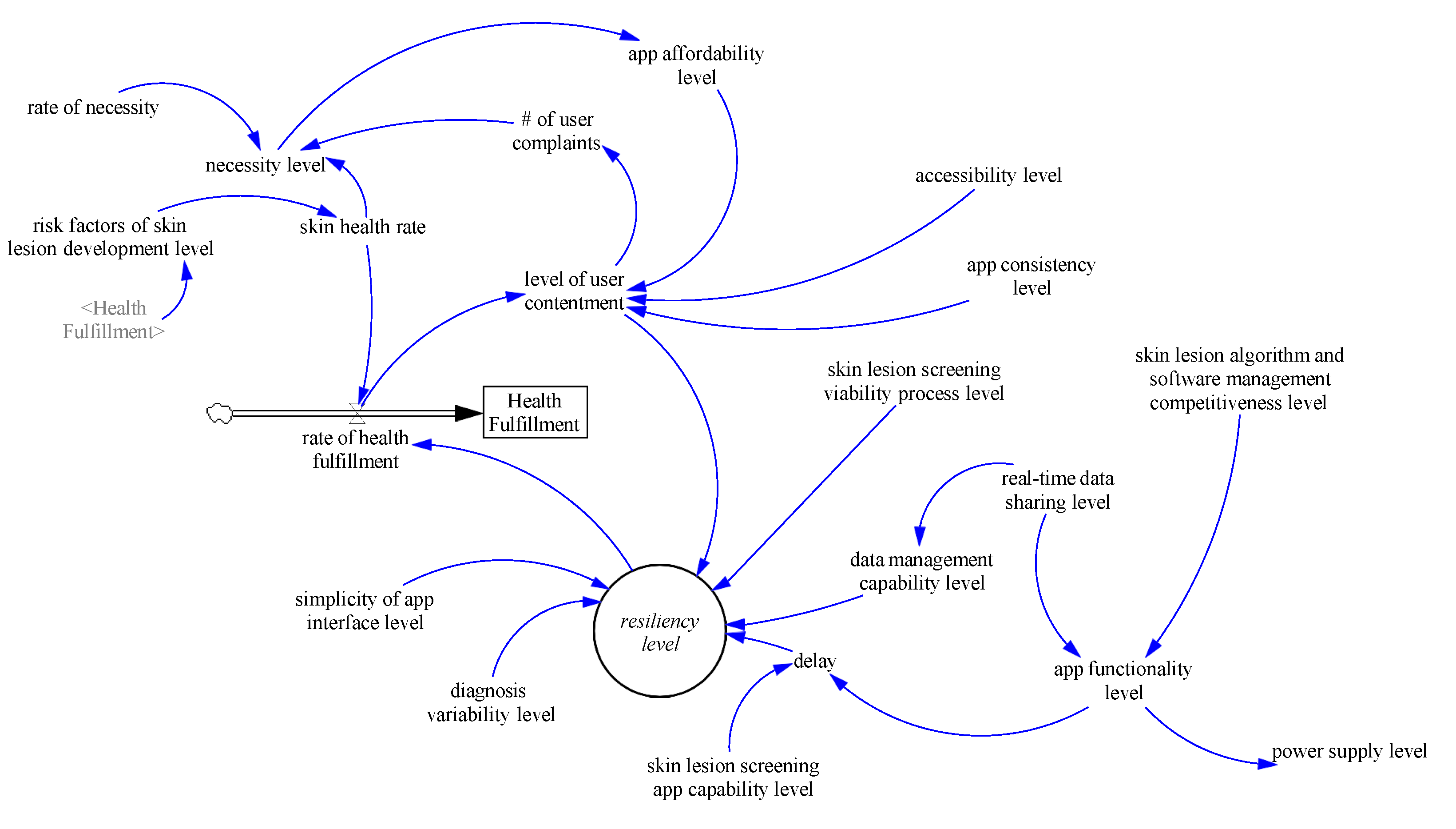
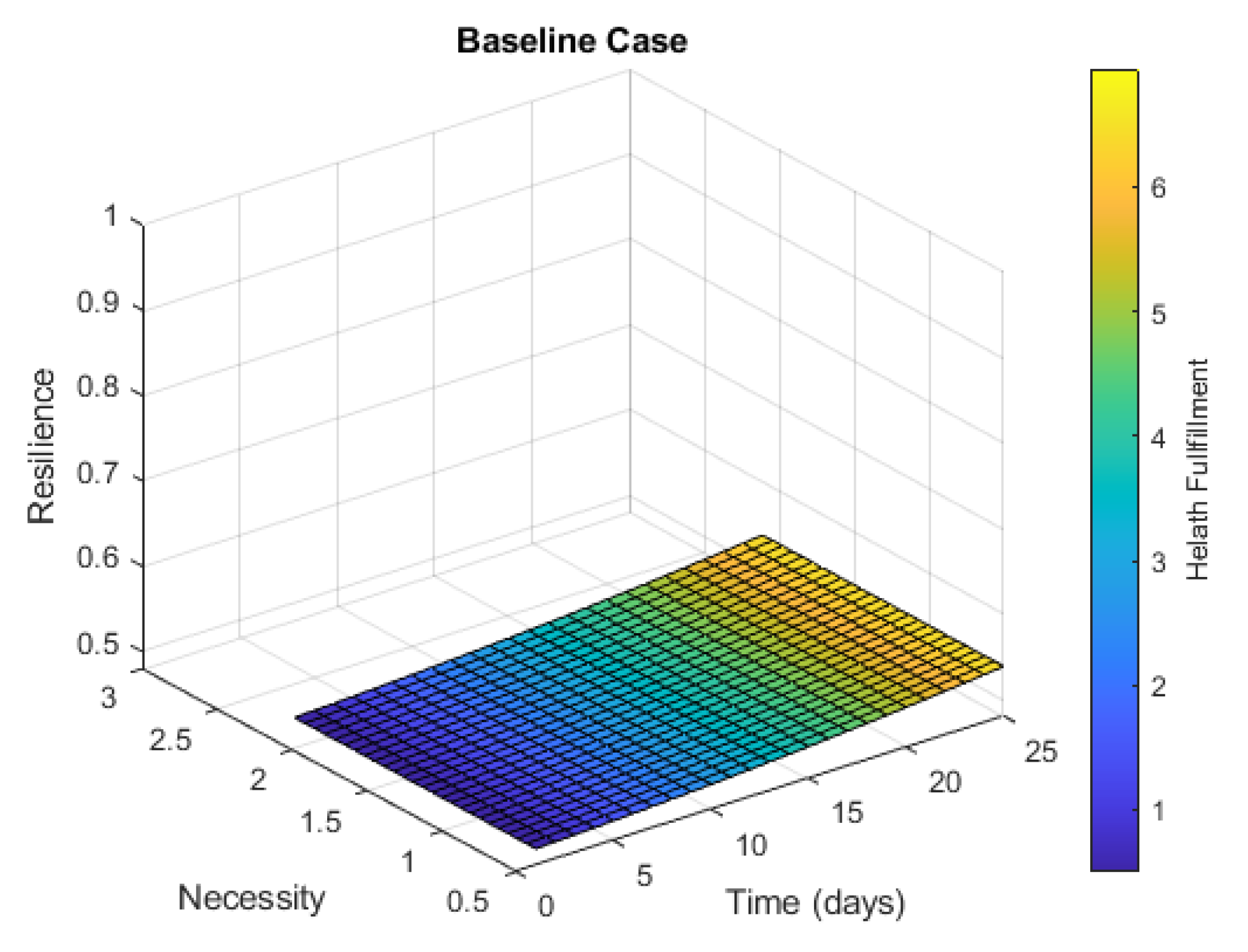
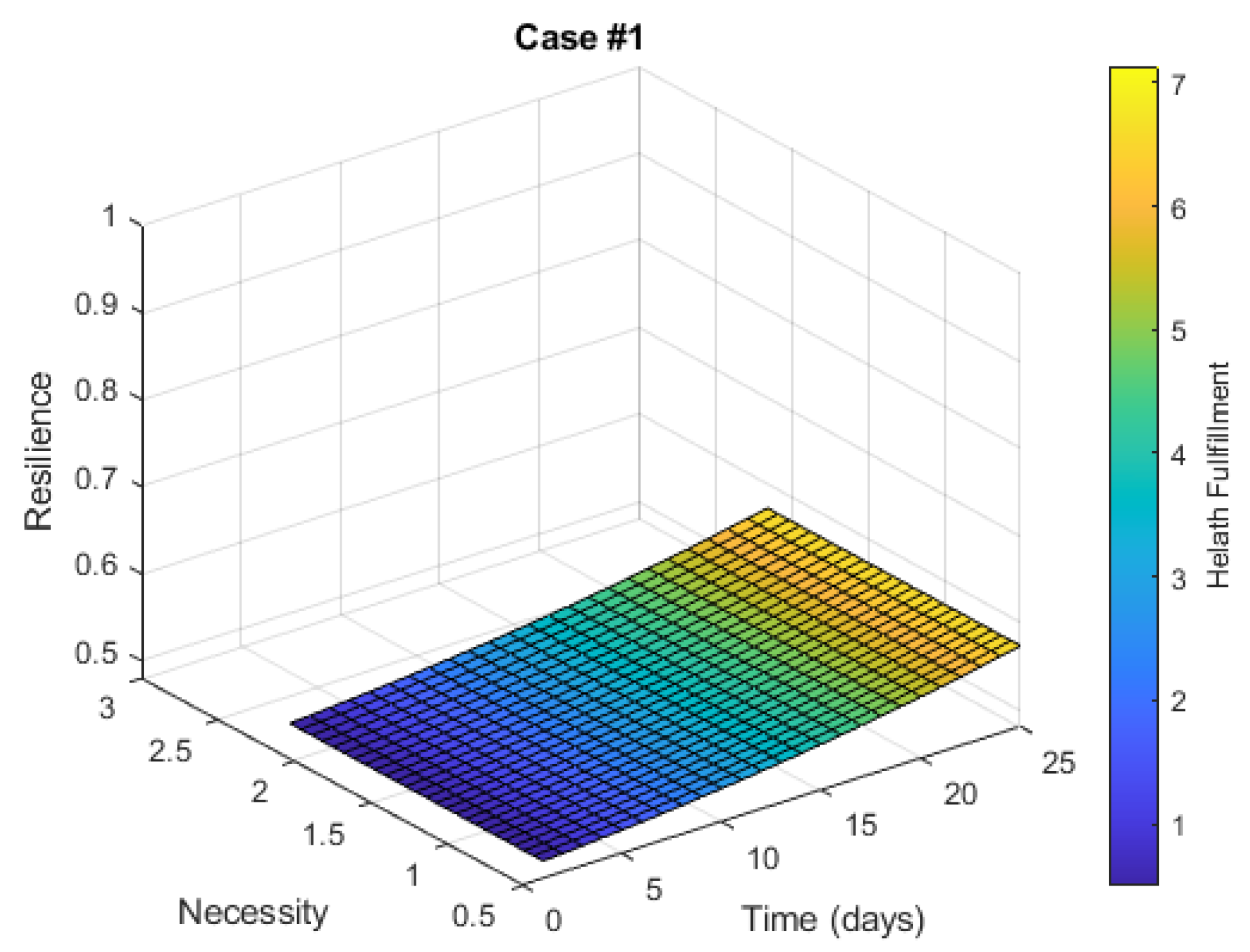

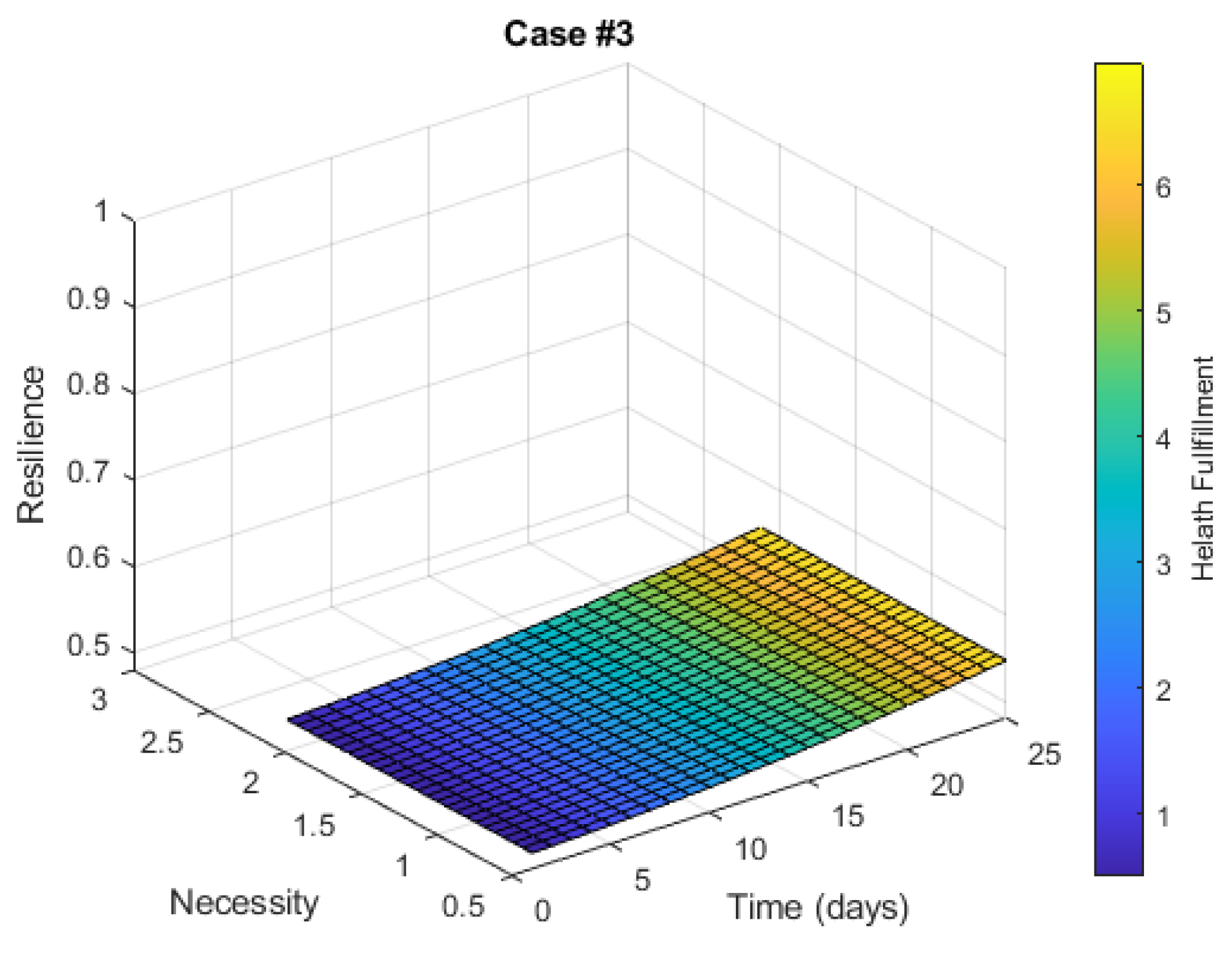
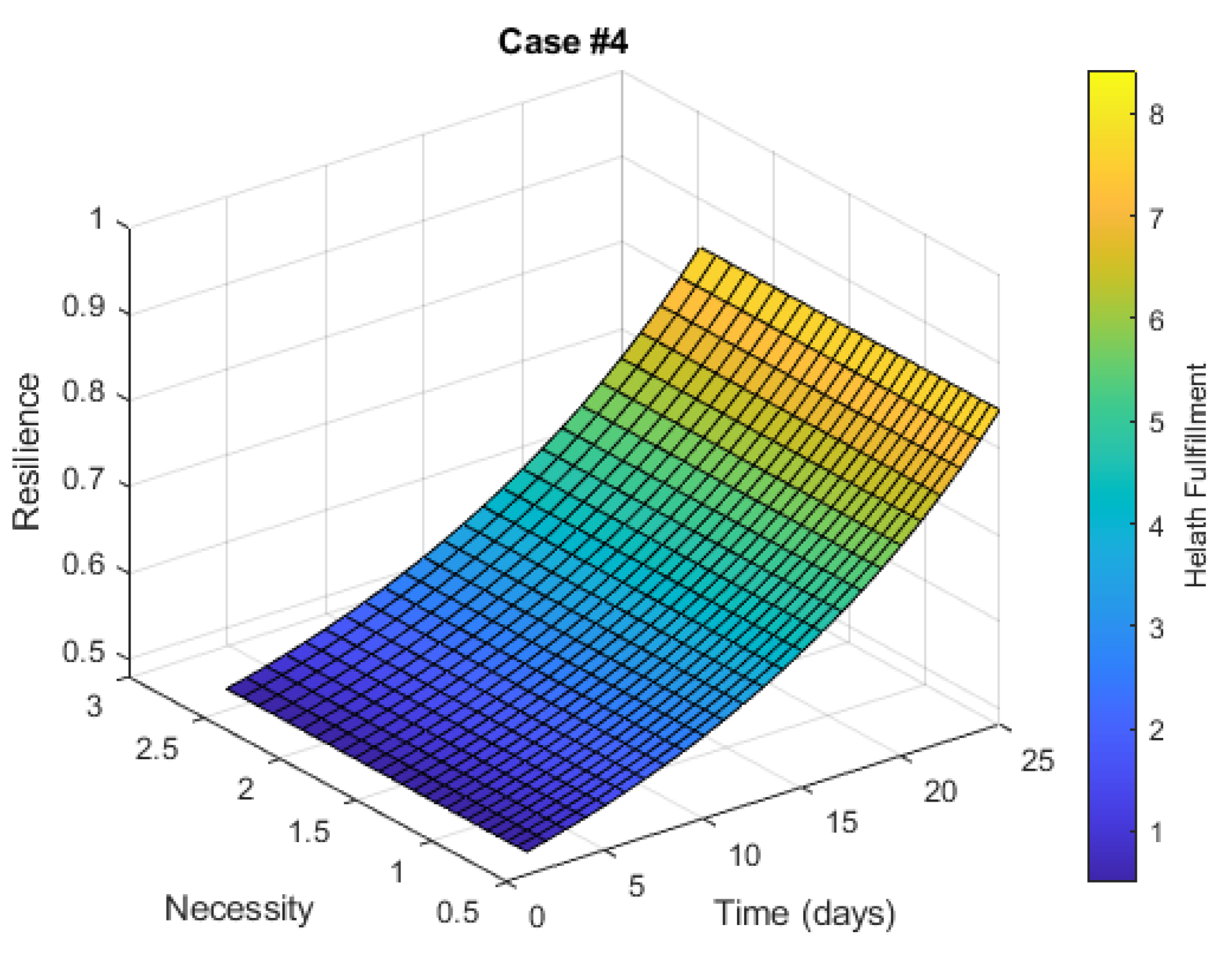
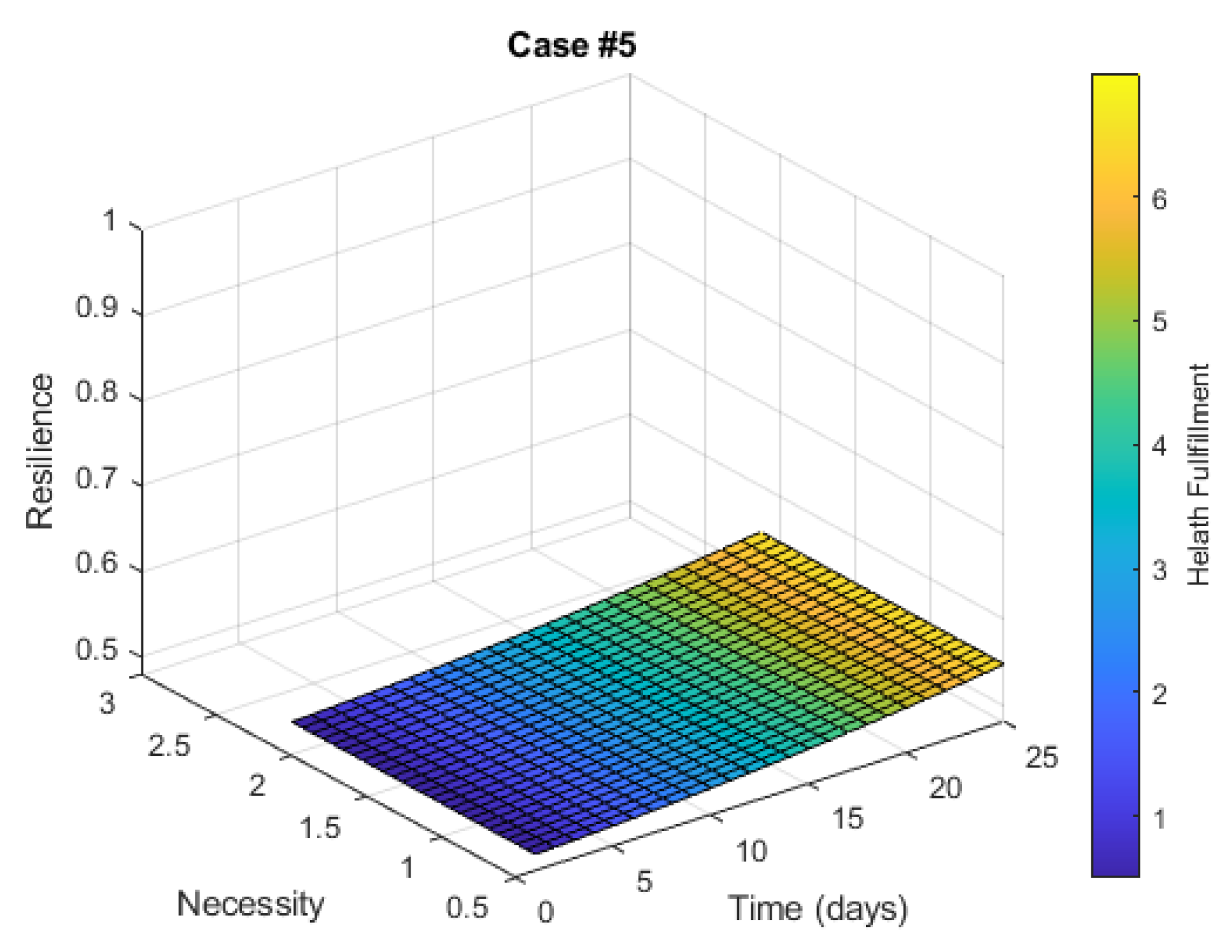

| Factor | Description | Capability | Vulnerability |
|---|---|---|---|
| Resiliency | The ability of the network to provide and maintain an acceptable level of service, and in some cases, to adapt and grow in the face of various faults and challenges, to normal operation [85] | ✓ | |
| Health Fulfillment | This refers to the well-being status | ||
| Population with Skin Problems | Percentage of people that have skin problems | ||
| Determinants of Skin Lesion Development | This factor includes environmental, geographical, climate, and demographics attributes that influence the development of skin lesions | ✓ | |
| Actual Necessity Level | Rate of need | ✓ | |
| Necessity Level | This refers to demand | ✓ | |
| App Affordability | Affordability level of the app in terms of cost and best value | ✓ | |
| App Consistency | App consistency level across various smartphone vendors | ✓ | |
| Accessibility | This refers to convenience of accessing the tool when needed | ✓ | |
| Equitability | This refers to the capability of each individual in need having same likelihood of being served | ✓ | |
| User Complaint | This represents the severity and/or number of complaints from users | ✓ | |
| User Contentment | This factor refers to the measure of user’s experience/reaction to received services and confidence in the app [25] | ✓ | |
| Skin Lesion Screening Viability Process | This refers to the feasibility (viability) of the skin screening method or process (including dermatoscope, smartphone, biopsy, etc.) | ✓ | |
| Simplicity of App Interface | This refers to the app’s user friendliness level | ✓ | |
| Adaptability | The interface should be flexible and adaptable to different user contexts and devices, ensuring usability across various platforms and screen sizes | ✓ | |
| Interactivity | This refers to the app’s ability in providing interactive user experience | ✓ | |
| Equipment Malfunction | This factor represents error or faults in the device | ✓ | |
| Diagnosis Variability | This refers to variance in diagnoses from one method to another | ✓ | |
| Data Management Capability | This refers to the app’s capability in terms of managing and updating data and, in general, the software | ✓ | |
| Realtime Data Sharing | App’s ability to collect, update, and transfer information instantly | ✓ | |
| Security Breach | This factor consists of attributes compromising security, privacy, and confidentiality such and unauthorized activity | ✓ | |
| App Functionality | This is the top level technological factor referring to the app performance | ✓ | |
| Skin Lesion Algorithm and Software Management Competitiveness | This implies the level of the app’s skin lesion analysis algorithm competitiveness among the state-of-art techniques | ✓ | |
| Image Resolution | This refers to the quality of image acquired for skin lesion analysis | ✓ | |
| Power Supply | This represents the battery level of the smart (hand-held) device | ✓ | |
| Skin Lesion Screening App Capability | This refers to the app’s capability in terms of including important skin lesion analyses features and functionalities | ✓ | |
| Software Malfunction | This refers to software and algorithmic errors | ✓ | |
| Delay | This represents the delay of app response in terms of time | ✓ |
| Factor | Simplicity | Skin | Skin Lesion | Skin Lesion | Diagnosis | Rate | All the |
|---|---|---|---|---|---|---|---|
| of App | Lesion App | Algorithm and Software | Screening | Variability | of | Other | |
| Interface | Capability | Management | Viability Process | Level | Necessity | Input | |
| Case | Level | Level | Competitiveness Level | Level | Variables | ||
| Baseline | 0.5 | 0.5 | 0.5 | 0.5 | 0.5 | 0.5 | 0.5 |
| Case #1 | 0.5 | 0.5 | 0.9 | 0.5 | 0.5 | 0.5 | 0.5 |
| Case #2 | 0.5 | 0.3 | 0.5 | 0.5 | 0.5 | 0.5 | 0.5 |
| Case #3 | 0.5 | 0.5 | 0.5 | 0.5 | 0.5 | 0.2 | 0.5 |
| Case #4 | 0.8 | 0.8 | 0.8 | 0.8 | 0.2 | 0.5 | 0.5 |
| Case #5 | 0.3 | 0.4 | 0.7 | 0.9 | 0.5 | 0.5 | 0.5 |
| Case #6 | 0.4 | 0.4 | 0.4 | 0.4 | 0.5 | 0.5 | 0.5 |
Disclaimer/Publisher’s Note: The statements, opinions and data contained in all publications are solely those of the individual author(s) and contributor(s) and not of MDPI and/or the editor(s). MDPI and/or the editor(s) disclaim responsibility for any injury to people or property resulting from any ideas, methods, instructions or products referred to in the content. |
© 2023 by the authors. Licensee MDPI, Basel, Switzerland. This article is an open access article distributed under the terms and conditions of the Creative Commons Attribution (CC BY) license (https://creativecommons.org/licenses/by/4.0/).
Share and Cite
Faezipour, M.; Faezipour, M.; Pourreza, S. Resiliency and Risk Assessment of Smart Vision-Based Skin Screening Applications with Dynamics Modeling. Sustainability 2023, 15, 13832. https://doi.org/10.3390/su151813832
Faezipour M, Faezipour M, Pourreza S. Resiliency and Risk Assessment of Smart Vision-Based Skin Screening Applications with Dynamics Modeling. Sustainability. 2023; 15(18):13832. https://doi.org/10.3390/su151813832
Chicago/Turabian StyleFaezipour, Misagh, Miad Faezipour, and Saba Pourreza. 2023. "Resiliency and Risk Assessment of Smart Vision-Based Skin Screening Applications with Dynamics Modeling" Sustainability 15, no. 18: 13832. https://doi.org/10.3390/su151813832





